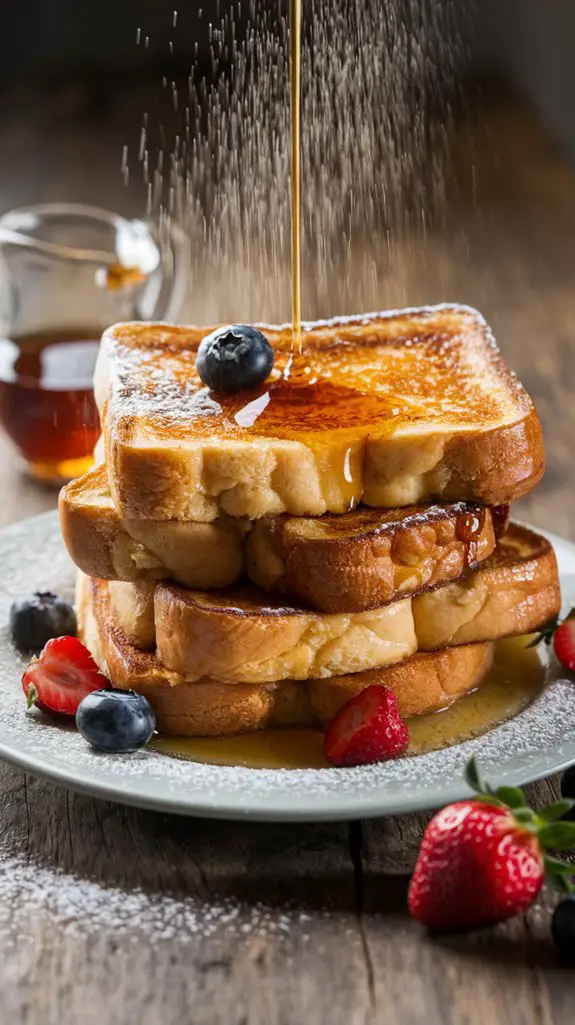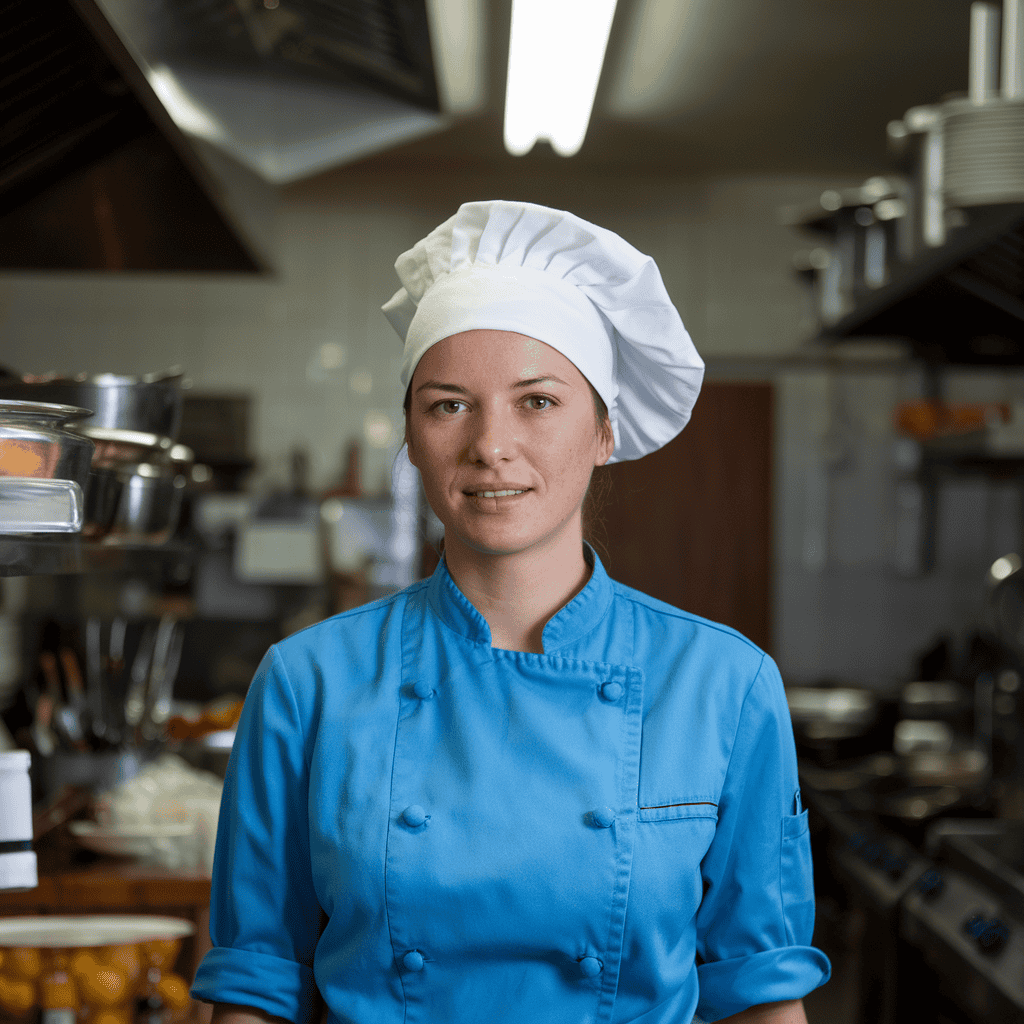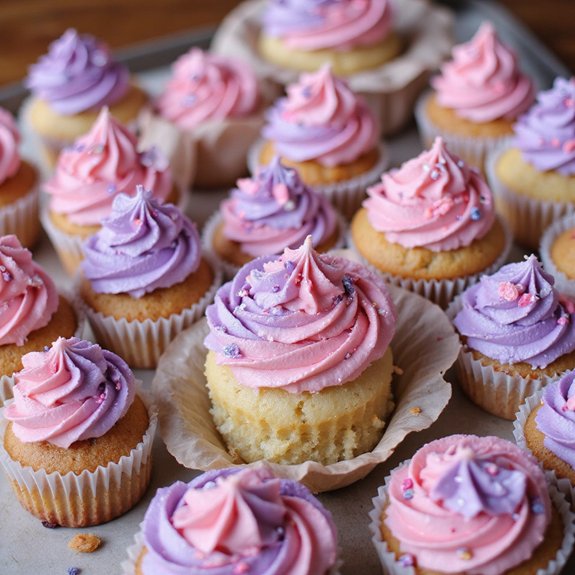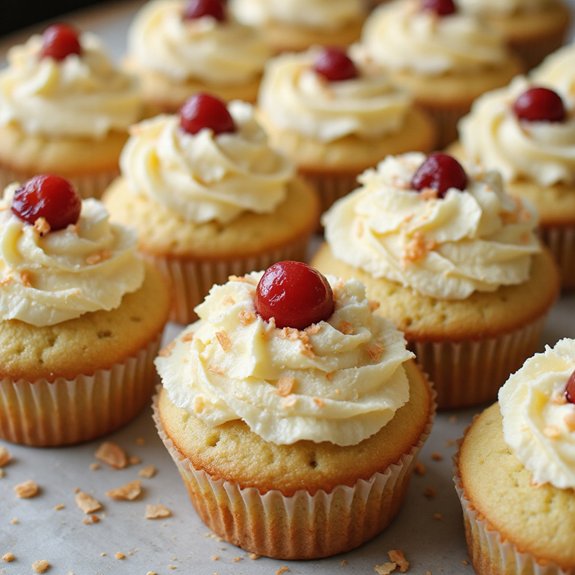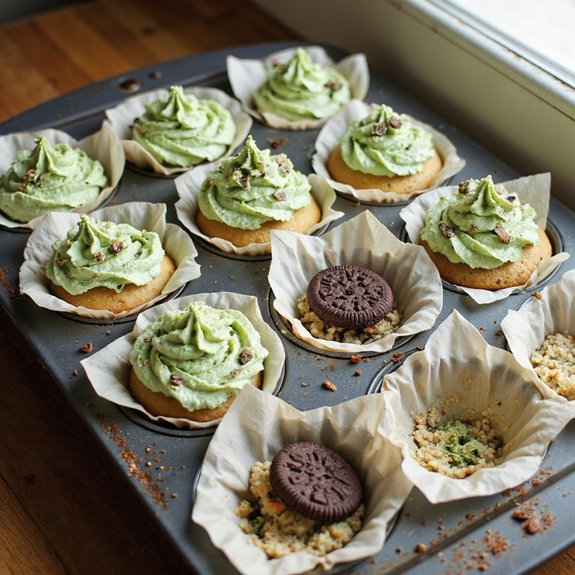You’ve probably enjoyed French toast at some point, but have you ever wondered what transforms simple stale bread into this breakfast favorite?
This dish, with its humble beginnings, is more than just a way to use up old bread.
From choosing the right type of bread to mastering the custard mix of eggs, milk, vanilla, and cinnamon, there’s a subtle art involved.
As you explore the steps to perfecting this classic, consider how the right toppings can elevate it further.
But what if there’s more to it than just the recipe? Let’s uncover the secrets behind the ultimate French toast.
History
Although French toast is now a staple in many breakfast menus around the world, its origins trace back to ancient Rome, proving its timeless appeal.
You’d find the Romans made a dish called “pan dulcis,” which involved soaking bread in milk, sometimes eggs, then frying it in oil or butter.
This technique preserved stale bread, transforming it into a delectable treat.
As this culinary practice spread across Europe, each culture adapted it, leading to variations like “pain perdu” in France, meaning “lost bread,” emphasizing the transformation of old bread into a delightful meal.
When you enjoy French toast today, you’re participating in a centuries-old tradition, refined over time but still rooted in its efficient, resourceful origins.
Recipe
French toast is a classic breakfast dish that is both delicious and easy to make.
Originating from ancient Rome, this dish has been adapted across various cultures, each adding its unique twist.
It involves soaking slices of bread in a mixture of eggs and milk, then frying them to a perfect golden brown.
The result is a soft and rich slice of bread that can be served with a variety of toppings, such as syrup, fresh fruits, or a dusting of powdered sugar.
This dish is versatile and can be made with different types of bread, including brioche, challah, or even whole grain.
The key is to use slightly stale bread, which absorbs the custard-like mixture without becoming too soggy.
Whether you prefer your French toast sweet or savory, it can be customized to suit your taste preferences, making it a favorite for both kids and adults alike.
Ingredients:
- Eggs
- Milk
- Vanilla extract
- Cinnamon
- Salt
- Bread slices
- Butter
- Maple syrup (optional)
- Powdered sugar (optional)
- Fresh fruits (optional)
To begin making French toast, whisk together eggs, milk, vanilla extract, cinnamon, and a pinch of salt in a shallow bowl until well combined.
Dip each slice of bread into the egg mixture, allowing it to soak for a few seconds on each side.
In a skillet over medium heat, melt a small amount of butter and place the soaked bread slices into the skillet.
Cook each side for about 3 to 4 minutes, or until they are golden brown and cooked through.
Serve immediately with your choice of toppings, such as maple syrup, powdered sugar, or fresh fruits.
For the best French toast, use bread that is a day or two old, as fresh bread can become too soggy when soaked.
If your bread is fresh, you can lightly toast it before dipping it in the egg mixture to help it hold its shape.
Feel free to experiment with different spices and extracts, like nutmeg or almond extract, to add a unique flavor to your dish.
Additionally, consider using a non-stick skillet or well-seasoned cast iron pan to ensure even cooking and prevent sticking. Enjoy your delicious homemade French toast!
Cooking Steps
You’ll start by whisking the eggs, milk, vanilla extract, cinnamon, and salt in a bowl until the mixture is smooth and uniform.
Next, soak each bread slice in this egg mixture, ensuring it absorbs the flavors without becoming overly soggy.
Melt butter in a skillet over medium heat and cook the bread slices until they’re golden brown on both sides, then serve them warm with a drizzle of maple syrup.
Step 1. Whisk Ingredients in Bowl
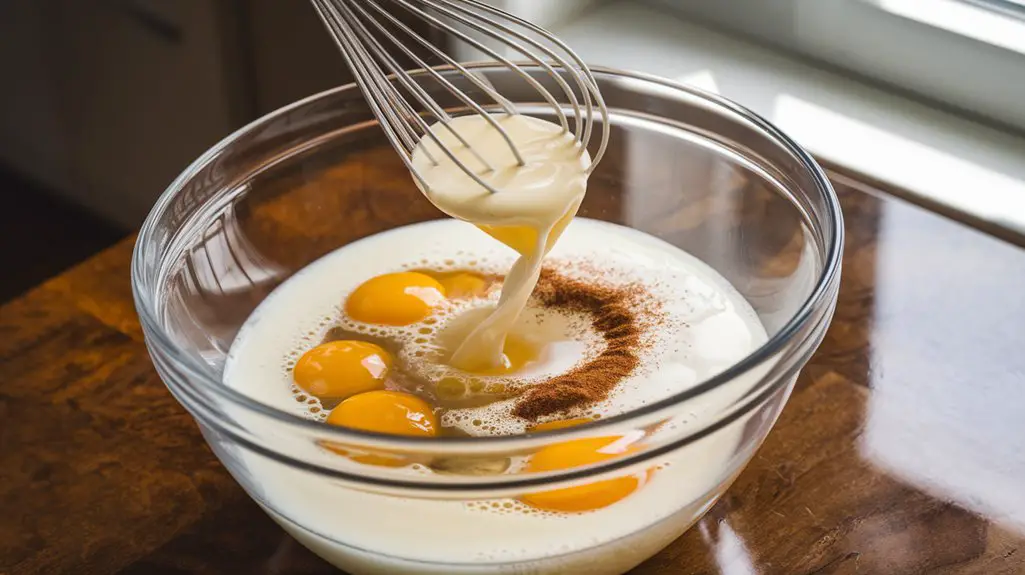
Begin by gathering all your ingredients to guarantee a seamless preparation process.
You’ll need eggs, milk, vanilla extract, cinnamon, and salt.
Crack the eggs into a large mixing bowl. Add the milk, making certain it’s well-measured for the perfect custard consistency.
Pour in a teaspoon of vanilla extract to enhance flavor. Sprinkle in a dash of cinnamon for aromatic warmth and a pinch of salt to balance sweetness.
Using a whisk, blend these ingredients thoroughly.
Make sure to break the yolks and mix until the mixture is smooth and uniform in color.
The goal is to create a cohesive blend without any streaks of egg white. This guarantees even soaking and flavorful French toast.
Your mixture is now ready for the next step.
Step 2. Soak Bread in Egg Mixture
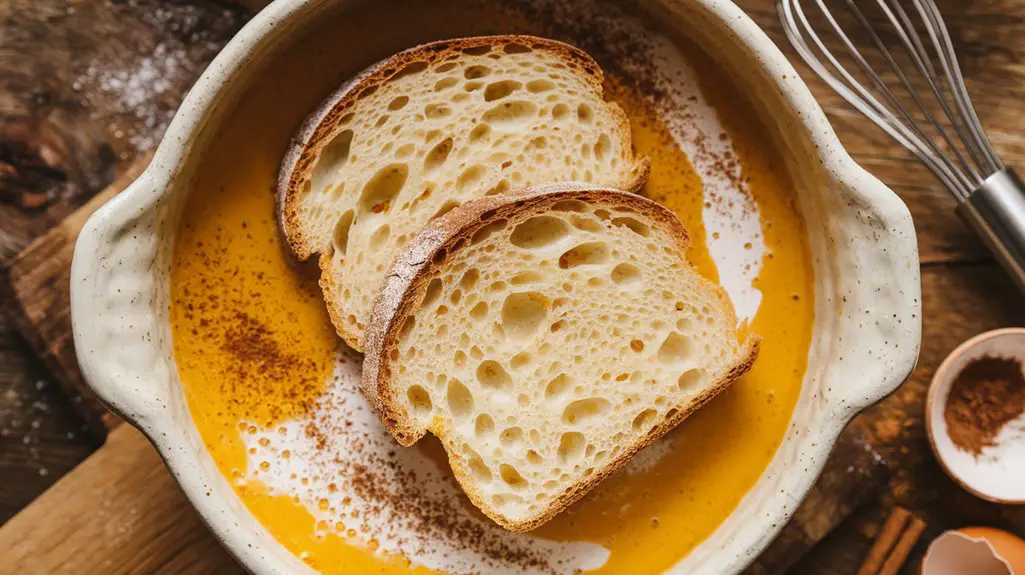
Immerse each slice of bread into the prepared egg mixture, guaranteeing both sides are thoroughly coated and soaked.
Use a gentle hand to prevent tearing the bread. Allow each slice to sit in the mixture for approximately 10-15 seconds per side.
This duration lets the bread absorb the flavors without becoming overly saturated.
Ensure a uniform coating by pressing lightly with a fork or spatula. After soaking, lift the bread carefully, allowing any excess mixture to drip off.
Transfer the soaked slices onto a plate, arranging them in a single layer to prevent sticking. This step guarantees even cooking in the next stage.
Repeat this process for all slices, maintaining consistency in the soaking time for each piece.
Step 3. Melt Butter in Skillet
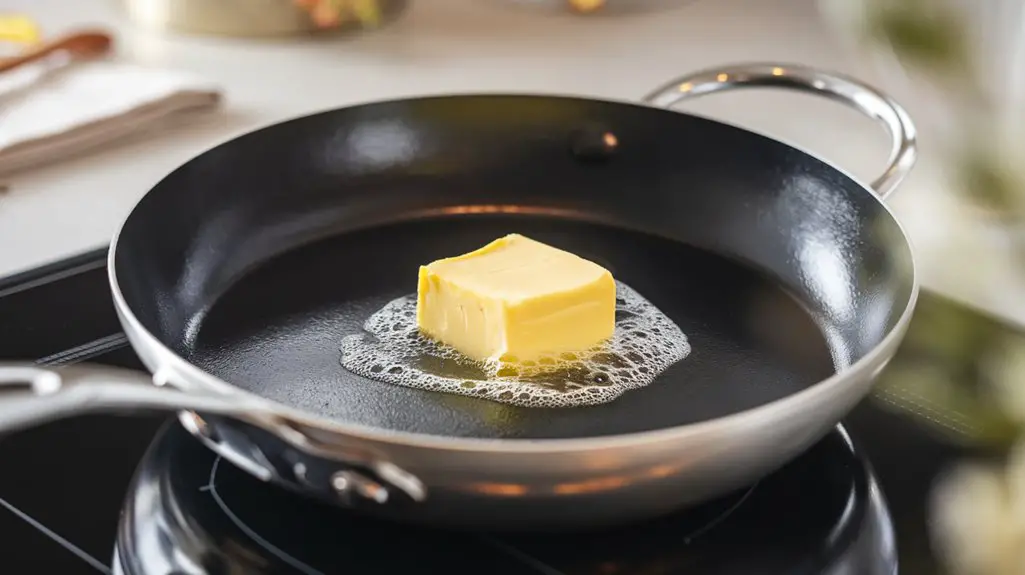
Heat your skillet over medium heat, ensuring it reaches an even temperature before adding any ingredients. This step is vital for achieving consistent results.
Once the skillet is hot, add a small pat of butter, approximately one tablespoon.
Allow the butter to melt completely, swirling the skillet gently to coat the entire surface evenly.
The butter should sizzle upon contact, indicating the skillet is at the correct temperature.
Watch closely as the butter melts; it should foam without browning. If it starts to brown too quickly, lower the heat slightly.
A well-melted butter layer prevents sticking and enhances flavor.
You’re now ready to introduce the soaked bread slices into the skillet, ensuring they cook evenly on all sides.
Step 4. Cook Bread Until Golden
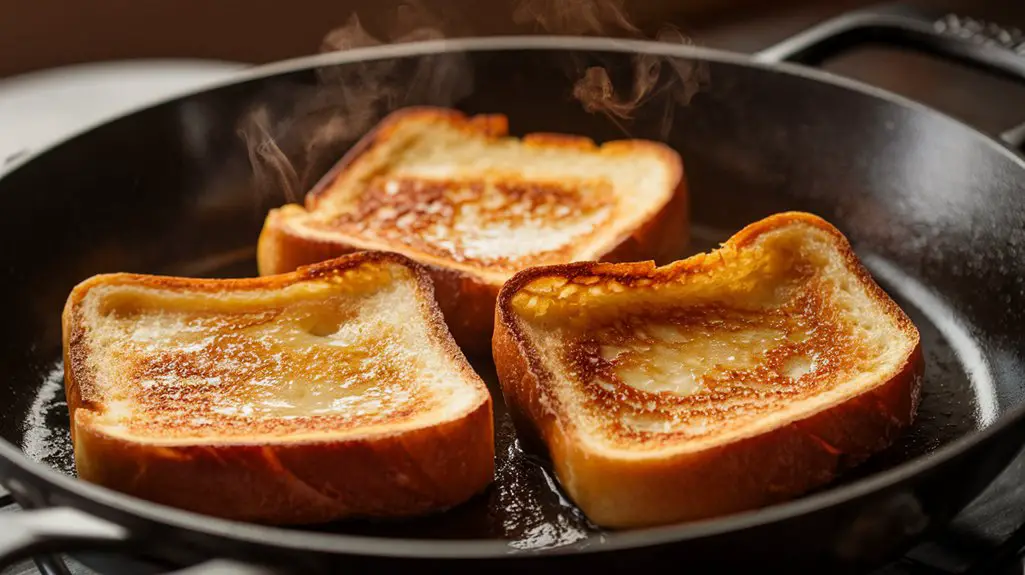
Place the soaked bread slices into the preheated skillet with care, making sure they lie flat for even cooking.
Allow each slice to cook undisturbed for 3 to 4 minutes. You’ll want to monitor closely for that perfect golden-brown hue.
Flip the slices gently using a spatula, applying the same timing to the other side.
Key points for achieving the ideal golden crust:
- Heat: Maintain medium heat to prevent burning.
- Spacing: Leave space between slices to make certain even heat distribution.
- Butter: Reapply if necessary to avoid sticking.
- Timing: Stick to the 3-4 minute guideline per side.
- Observation: Watch closely for color changes.
Once both sides are golden, remove the slices immediately to prevent overcooking. Your French toast is now ready for the next step.
Step 5. Serve With Maple Syrup
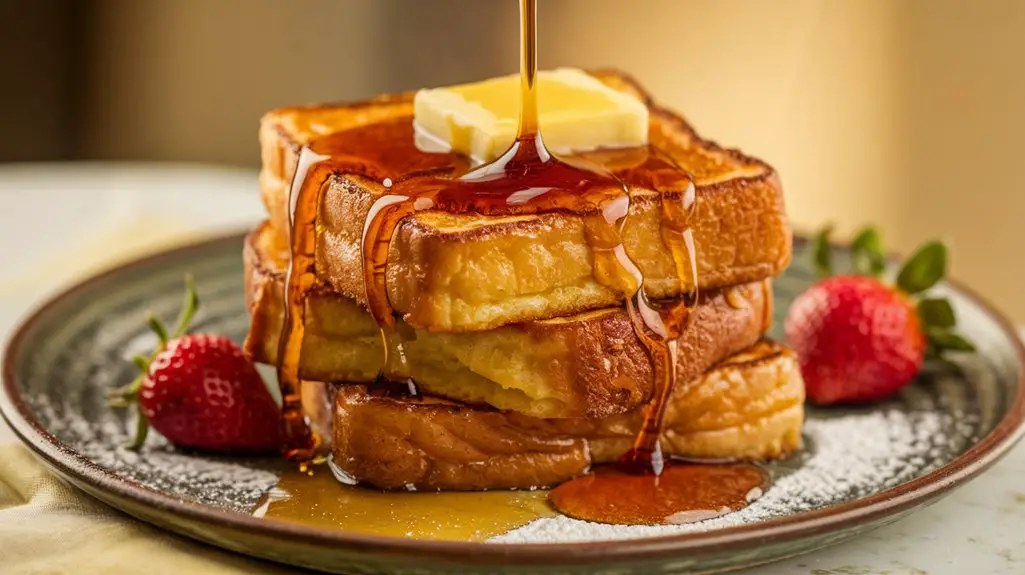
Once your French toast slices are perfectly golden on both sides, promptly transfer them to a serving plate to maintain their warmth and texture.
Before reaching for the maple syrup, verify it’s at room temperature or slightly warmed to enhance its pourability and flavor.
Gently drizzle the syrup over each slice, allowing it to permeate the bread’s nooks and crannies.
To achieve an even distribution, tilt the plate slightly as you pour. This guarantees every bite is infused with the sweet, rich essence of maple.
Be mindful not to oversaturate; a modest amount highlights the toast’s flavor without overwhelming it.
Serve immediately to preserve the ideal temperature and consistency, delighting your senses with each perfectly balanced bite.
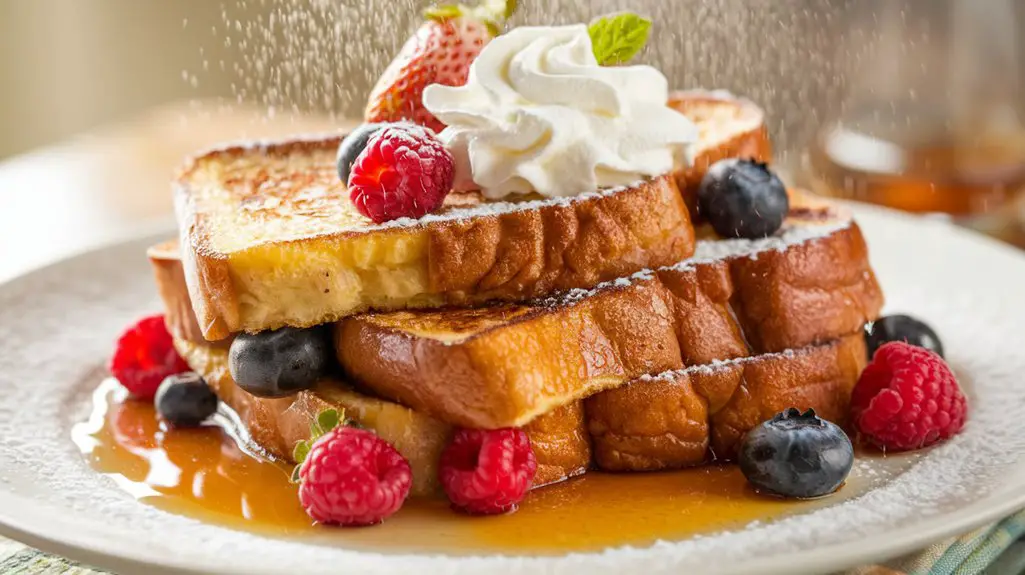
Select toppings that complement the subtle sweetness and crisp exterior of the toast. Consider these options:
- Fresh berries: Rinse and pat dry beforehand for a vibrant, juicy addition.
- Maple syrup: Warm slightly to drizzle smoothly over the toast.
- Powdered sugar: Use a fine sieve for an even, light dusting.
- Whipped cream: Prepare using heavy cream and a hint of vanilla.
- Nut toppings: Toast almonds or walnuts for a crunchy texture contrast.
Arrange your selections thoughtfully, allowing each addition to enhance the overall presentation and flavor profile.
Final Thoughts
When you perfect the art of making French toast, it becomes a rewarding culinary skill that enhances your breakfast repertoire. Precision in each step guarantees a consistently delectable dish.
Always choose slightly stale bread for ideal absorption of the egg mixture without becoming soggy.
Your skillet should be preheated and well-buttered to achieve that golden-brown finish.
Here’s a concise checklist to elevate your French toast game:
- Use day-old bread: It absorbs the custard mixture better.
- Mix thoroughly: Whisk ingredients until fully combined.
- Monitor skillet temperature: Medium heat prevents burning.
- Experiment with flavors: Try adding nutmeg or almond extract.
- Serve promptly: French toast is best enjoyed hot.
Mastering these details guarantees a delightful breakfast experience every time.

